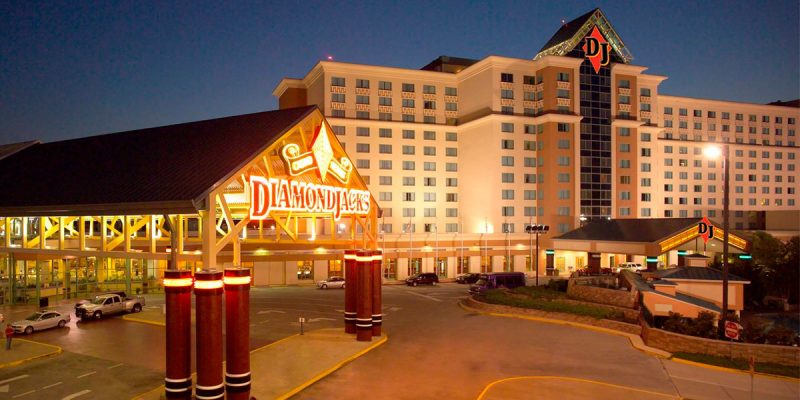Bossier City and Louisiana soon will discover the limits of casino gambling as a source of economic development and government revenue with one of the state’s most venerable riverboat operations on the cusp of sinking and perhaps unsalvageable.
In May, 2020 the city’s DiamondJacks casino – the fourth-oldest continually-operating in the state and longest under the same license – announced it would shut its doors permanently, a victim of the Wuhan coronavirus pandemic caused by having the most co-morbid condition of all 15 licensees. It regularly competed for the sickest man of Louisiana casinos with the small-market Amelia Belle and the Baton Rouge market’s version of the canary in coal mine warning of market saturation, the Belle of Baton Rouge.
As the Isle of Capri it started off strongly almost three decades ago, and as late as the end of the century ran up $123 million in revenues that year. But it went out with a whimper, having just a fifth of those revenues when fiscal year 2020 closed its books and the lowest revenue per admission.
The decline came with warning over many years, prompting efforts to send it to a location presumably without competition and with enough potential market to survive, which turned out to be various iterations of getting it near Mississippi. In 2018 its new owners floated a plan to move the license to Tangipahoa Parish, a move rejected by legislators. In 2019, a study suggested it decamp to Ouachita Parish, but that couldn’t even merit a public hearing. Their latest attempt, busting out to St. Tammany Parish at least made it through the Legislature, only to have that parish’s voters reject it last fall.
That outcome meant the owners had 60 days either to reopen the facility under a plan acceptable to the Louisiana Gaming Control Board, sell it, or surrender the license. Granted a few days extension until Feb. 17, a plan to restart seems in the offing.
Whether the Board will judge this adequate requires a leap of faith on the owners’ part. Months after closing, a liquidation sale removed a lot of furniture and fixtures which would need replacing. Further, for years prior to closure, little had been put into the aging property in anticipation of its possible relocation; as a point of reference, in FY20 it received only just over three-quarters of a million dollars in capital improvements while its five neighbors poured in $48 million, although about two-thirds of that neighboring Horseshoe ponied up.
And to top it all off, to become competitive in a marketplace where even five boats might be too many – Boomtown and Sam’s Town regularly perform at about half the revenue level (latest annual revenue figures) of the market’s next highest performer, the newly-named Bally’s Shreveport – probably requires the boat becomes amphibian and, as a couple of others are doing elsewhere in the state, crawling operations onto land as permitted by a legal change a couple of years ago. That dramatically would increase expenditures in an uncertain environment.
Advertisement
That milieu has deteriorated because, unlike the other markets in south Louisiana, external competition has increased while area population has decreased. Texas gaming hasn’t expanded, which helps the Lake Charles market which must compete only against an American Indian casino north of Houston, but Oklahoma’s has after major legal revisions in the early 2000s and again later in that decade, with now well over 100 locations, dozens of which offer table games and a continually upward-spiraling revenue picture that not only keeps Oklahomans in-state but sucks in Texans and Arkansans as well. Tribal casinos there also have a distinct cost advantage, with Oklahoma taking a far lower portion of the revenue than Louisiana does from its licensees.
Things are going so well there that one casino – just across the Red River from Texas just north of the Metroplex, half the distance from Shreveport/Bossier City – alone just completed a $600 million expansion, or more than all spent by Louisiana boats for the past several years. In fact, only the two long-time Lake Charles casinos have approached that figure for total capital outlay in their entire existences.
This competition severely impacts northwest Louisiana, where over half of casino visitors come from at least 150 miles away or from another state, and the region further hurts because its population has diminished. Bossier, Caddo, De Soto, Red River, and Webster Parishes have dropped nearly 11,000 residents since 2010, reducing local demand.
Inability to get DiamondJacks – where almost nine in ten visitors came from out of the area – up and running again on an annual basis has cost Bossier City and Parish about $1.25 million in fee revenue and a chunk of a similar amount in property taxes, as well as over 300 full-time equivalent jobs and $18.5 million in annual visitor spending. The state saw 2020’s $5.5 million in fee remittances disappear. Not only does it look unlikely that the area will see this bounty again, the state may not either as the available markets, even the most lucrative Lake Charles one, appear saturated making the 15th license uncertain whether it could break even operating anywhere else that current law permits.
Advertisement
Advertisement

